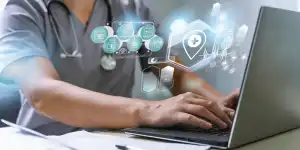How to Maximize Patient Care Through Interoperability in Healthcare
In 2024, the importance of interoperability in healthcare has never been more evident. A recent study revealed that over 70% of healthcare organizations reported increased patient engagement when leveraging interoperable systems. Furthermore, healthcare interoperability is projected to surpass USD 4.5 billion by 2026, growing at a rate of 12.9% CAGR, according to research by Facts & Factors.
Picture this: A patient with a complex medical history visits a new specialist. Thanks to interoperability, the specialist can quickly access the patient’s complete medical records from previous healthcare providers, avoiding unnecessary tests and treatments. This scenario exemplifies how interoperability not only enhances patient care but also streamlines operations in a fragmented healthcare landscape.
In this blog, we’ll explore what interoperability in healthcare means, its significance, major use cases, and practical strategies to improve it, all aimed at maximizing patient care.
What is Interoperability in Healthcare?
Interoperability in healthcare refers to the ability of different healthcare systems, devices, and organizations to seamlessly exchange and share information. It includes electronic health data, medical records, test results, and other relevant information that can be accessed and used across various platforms and applications. Interoperable systems ensure that data can be accurately interpreted, exchanged securely, and used cohesively to optimize health outcomes.
Importance of Interoperability in Healthcare
Accessing and sharing health data has always been challenging due to its sensitive nature as it requires strict privacy and security measures. It comes with a dilemma that if this data fails to secure access can lead to significant harm. Such issues in interoperability result in an incomplete understanding of individuals’ health needs which leads to suboptimal outcomes and increased costs.
Despite the rise in electronic health record (EHR) usage, integration remains a challenge. While many hospitals can access external data, its integration into patient records often comes across as a difficult task. With interoperability in healthcare, health professionals not only provide comprehensive patient care but healthcare organizations understand utilization rates, meet population needs and drive informed research.
Enhanced interoperability shifts the focus from fragmented data views to holistic patient care models, improving safety, and enhancing overall healthcare experiences.

Major Examples of Interoperability in Healthcare
Interoperability in healthcare refers to the seamless exchange and utilization of health data across various systems, tools, and entities.
Major Use Cases of Interoperability in Healthcare
Interoperability in healthcare allows for the seamless exchange and utilization of health data across various systems and entities. Here are practical use cases:
- Digital Health Records (DHRs) and Health Data Exchange (HDX):
DHR systems like Epic and Cerner enable secure sharing of patient information among healthcare providers. For example, a multi-hospital system in California successfully implemented HDX, resulting in a 40% reduction in duplicate testing by enabling real-time access to patient records across facilities. - Fast Health Interoperability Resources (FHIR):
FHIR serves as a framework for sharing EHRs between systems, enhancing communication among platforms. For instance,
Apple Health uses FHIR to integrate health data from various devices, allowing patients to have a consolidated view of their health information, which facilitates more informed healthcare decisions. - Telehealth and Remote Monitoring:
Integrated platforms enable seamless data sharing between patients and healthcare providers during virtual consultations. A 2024 study found that hospitals leveraging telehealth interoperability reported a 50% increase in patient adherence to treatment plans due to improved communication and accessibility. - Patient Engagement Platforms:
Companies like MyChart allow patients to access their health records, schedule appointments, and communicate with their care teams. This empowered engagement has led to a 30% increase in patient satisfaction scores among users. - Interoperable Medical Devices:
Devices such as insulin pumps and heart rate monitors can now transmit data directly to EHR systems. For example, Medtronic’s diabetes management system integrates seamlessly with healthcare providers’ EHRs, allowing for real-time monitoring and adjustments in treatment, significantly improving patient outcomes.

Benefits of Interoperability in Healthcare
Healthcare interoperability serves as the foundation for providers, enabling a comprehensive and real-time understanding of a patient’s medical history. Key benefits include:
- Continuity of Care: Seamless health information exchange guarantees consistent care delivery. A recent study revealed that patients with access to interoperable health data experienced a 35% reduction in hospital readmissions, underscoring the impact of improved data sharing on patient outcomes
- Improved Efficiency: Streamlined data sharing reduces manual work and paperwork, saving time and decreasing errors. Organizations using interoperable systems report an average of 20% reduction in administrative burdens.
- Cost Savings: Interoperability leads to significant cost benefits by eliminating redundant tasks and optimizing resource utilization. A 2024 analysis indicated that interoperable systems could save healthcare organizations up to $1.5 million annually.
- Patient Empowerment: Access to health data promotes transparency and encourages active patient participation in healthcare decisions. Engaged patients are 80% more likely to adhere to treatment plans.
- Advancing Public Health: Rapid data exchange on disease outbreaks and health trends enhances population health management. Public health departments using interoperable systems can respond to outbreaks 30% faster than those that do not.
- Streamlined Administrative Processes: Automation of tasks like billing and insurance claims reduces workload and enhances workflow efficiency, allowing healthcare providers to focus more on patient care.
- Enhanced Data Analytics: Comprehensive data analytics provide insights into public health, treatment effectiveness, and healthcare trends, supporting informed decision-making.

How to Improve Interoperability in Healthcare
Improving interoperability in healthcare involves several key strategies:
Analyze the Interoperability Status of Healthcare Providers
With newly established standards for healthcare interoperability, challenges arise when organizations or vendors fail to align with FHIR standards. Many times these misalignments hinder healthcare tech vendors from accessing and integrating essential data. To achieve desirable or correct results, healthcare tech teams should evaluate how hospitals and practices perform with interoperable systems. Understanding and implementing changes according to industry standards is crucial to fully utilize these advancements such as EHR and EMR.
Understand Data Accessibility
Nowadays, it is important to utilize standardized APIs in the health sector. It enables various systems to communicate seamlessly and allow individuals secure access to health information through mobile phones and other digital devices.
One of the significant challenges for healthcare tech vendors is not knowing what data is available, whether it comes from a source system, what the data means, or where it is located. Therefore, organizations must define the type of data they have, what data they plan to exchange, where it needs to be transmitted, and how the recipient systems will use it before data exchange.
Active Collaboration Among Providers, Vendors, and Staff
Improved EHR usability and interoperability requires transparent collaboration between vendors and healthcare organizations. This collaboration is crucial not only during the implementation phase but also for ongoing interoperability efforts. For instance, a primary care practice needs to accurately enter and extract EHR data to generate quality measures and other metrics.
Ensuring that teams across health technology systems develop an effective method for integrating EHR data is crucial. This approach is a key step in enhancing care delivery and patient outcomes through collaboration.
Prioritize Data Security
Data security is important in healthcare. A lack of comprehensive security measures can jeopardize patient records, which can put lives at risk. To achieve interoperability, security must be prioritized in the development process. Healthcare stakeholders must build trust and align health systems and plans to strengthen secure healthcare information exchange.
Implementing a secure API approach to enhance interoperability will help create a robust health IT system focused on quality care. A team with diverse skills is vital for developing a secure, interoperable system that considers the user experience.
Continuously Train Staff on Healthcare Interoperability Improvements
Successfully upgrading systems often requires significant involvement from healthcare providers. Involving staff during system improvements ensures they can smoothly adapt to changes and understand their benefits. For healthcare interoperability, familiarizing medical staff with interoperability tools allows them to efficiently retrieve and share necessary information. This reduces workloads, facilitates the transition to digital systems, and improves patient activity documentation.

How Interoperability in Healthcare Empowers the Future of Patient Care
Advances in interoperability and connectivity are paving the way for a more integrated and efficient healthcare system. To fully realize these benefits, it is crucial to overcome existing barriers to interoperability and leverage the potential of interconnected health systems. Such a big change can enhance patient experience through several key improvements.
Facilitate Care Coordination
Interoperable systems allow for seamless communication and information exchange among healthcare providers. It enhances care coordination, reduces fragmentation, and ensures that all members of a patient’s care team are well-informed and on the same page.
Enhance Patient Engagement
When patients have access to their comprehensive health records, they become more empowered to participate in their care. Their involvement includes making informed decisions, collaborating effectively with healthcare providers, and sharing vital health information, all of which contribute to improved care outcomes.
Improve Patient Safety and Reduce Medical Errors
Comprehensive and accurate patient information is essential for healthcare providers to make well-informed decisions. This reduces the risk of medication errors, allergy mishaps, misdiagnoses, and other adverse events.
Proper Knowledge of Patient’s Condition
Real-time clinical information ensures that providers are fully aware of their patients’ histories and needs. This not only reassures patients that they are known and valued but also minimizes the need for them to repeatedly share their medical histories, thus respecting their time and enhancing their overall care experience.
Conclusion
Interoperability in healthcare is not merely a technical upgrade; it represents a transformative shift towards a more integrated, patient-centered approach to care.
The benefits of interoperability are substantial and measurable: organizations that implement interoperable systems see a 30% reduction in administrative costs, a 25% decrease in duplicate testing, and a 20% improvement in patient outcomes (HIMSS Analytics, 2024). By facilitating seamless data exchange, these systems enhance patient safety, streamline workflows, and significantly improve clinical outcomes. When healthcare providers have access to comprehensive patient information, they are empowered to make informed decisions, thus reducing errors and enhancing the quality of care.
At OmniMD, we are committed to helping healthcare organizations navigate the complexities of interoperability. If you’re ready to take your interoperability strategy to the next level, contact us today. Let us partner with you to maximize the potential of your healthcare systems and enhance patient care in your organization. Together, we can build a future where every patient receives the comprehensive, informed care they deserve.

All-in-One EHR Software
Streamline Your Practice with a Complete EHR Solution

 Written by Neha Singh
Written by Neha Singh
 Reviewed by Shivani Joshi
Reviewed by Shivani Joshi